Understanding Myopia Vs. Hyperopia: The Difference Explained
If you are someone who wears glasses or contacts, you may have heard of terms such as myopia and hyperopia. These two conditions are very common and affect millions of people worldwide. In this article, we will explain the key differences between myopia and hyperopia.
What is Myopia?
Myopia, also known as nearsightedness, is a refractive error where your eye is unable to focus on distant objects. This occurs when the cornea, which is the front part of the eye, is too curved or when the eyeball is too long. As a result, light entering the eye is focused in front of the retina, causing distant objects to appear blurry. People with myopia can easily see objects up close but have trouble seeing things far away.
What is Hyperopia?
Hyperopia, also known as farsightedness, is a refractive error where your eye is unable to focus on nearby objects. This occurs when the cornea is too flat or when the eyeball is too short. As a result, light entering the eye is focused behind the retina, causing near objects to appear blurry. People with hyperopia can easily see objects far away but have trouble seeing things up close.
What are the symptoms of Myopia and Hyperopia?
The symptoms of myopia and hyperopia are different. With myopia, people may experience squinting, headaches, and eyestrain when trying to focus on distant objects. They may also have trouble seeing road signs or the board at school. With hyperopia, people may experience eyestrain, fatigue, and headaches when trying to focus on nearby objects. They may need to hold reading materials far away to see them clearly.
How are Myopia and Hyperopia treated?
Both myopia and hyperopia can be corrected with glasses, contact lenses, or refractive surgery. Glasses and contact lenses work by altering the way light enters the eye so that it focuses on the right spot on the retina. Refractive surgery involves reshaping the cornea to correct the refractive error.
Conclusion
In conclusion, myopia and hyperopia are quite common and affect millions of people worldwide. While myopia causes problems in distance vision, hyperopia causes problems in near vision. If you experience any of the symptoms of myopia or hyperopia, it is important to see an eye doctor for a comprehensive eye examination. With the right treatment, you can have clear vision and better quality of life.
Table difference between myopia and hyperopia
| Parameter | Myopia | Hyperopia |
|---|---|---|
| Definition | Short-sightedness, where distant objects appear blurry | Long-sightedness, where near objects appear blurry |
| Causes | Abnormal elongation of the eyeball, or an excessively curved cornea, which causes light to focus in front of the retina | Eyeball that is too short, or a cornea that is too flat, which causes light to focus behind the retina |
| Symptoms | Difficulty seeing distant objects clearly, headaches, eye strain, squinting | Difficulty seeing close-up objects clearly, eye strain, fatigue, headaches, blurred vision after reading or doing close work |
| Treatment | Corrective glasses or contact lenses, laser eye surgery, orthokeratology, intraocular lens implants | Corrective glasses or contact lenses, laser eye surgery, intraocular lens implants |
